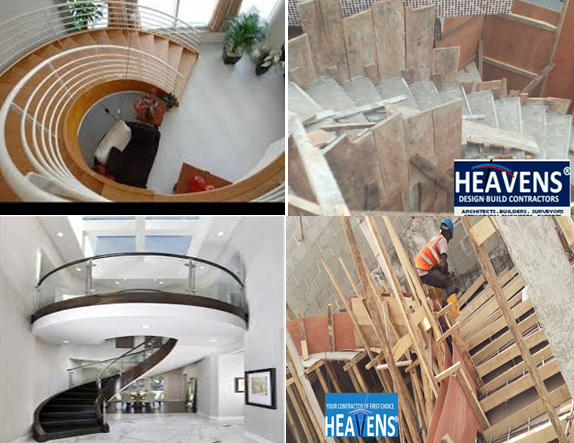You can beat this only if you can.
It’s staircase on a whole new level – the floating helical stairs; with long
splay bearing and virtually no support in between. An amazing piece for style
and functionality; helical staircases can redefine a space and give it the
meaning and respect it truly deserves. There is not much of a big deal in the
construction of this fanciful type of staircase but if you miss it somewhere,
down it goes and it takes the user with it to the ground and that’s a disaster!
The rate of failure of helical stairs is known to be higher than several other
types of stairs and this is because they are mostly self-supporting or ‘floating’.
Helical stairs are made from several types of
materials, mostly reinforced concrete, metal, glass, timber or a combination of
any of these. Whichever primary material is used, the principle remains the
same. Most helical stairs are fixed at both ends with beams running from end to
end throughout the splay and the other sides into a load-bearing element which
transfers load from the thread on to the beams and then to the fixed ends.
Essentially, stairs help as a transit line
from one floor/level in a building or structure to another. In order to
effectively perform this function; they must be strong and stable. They must be
able to support users well enough without excessive vibration and shear
throughout the effective life span of the structure. The finishes on stairs
should be non-slip and able to withstand various temperature changes, moisture,
impact, wear and tear, and provide good resistance to fire as they are preferred
over typical spiral stairs in cases of emergency. The expected traffic on a
stair technically affects its design; helical stairs designed for residential
buildings are quite different in structural design than those for public use.
For instance, the provisions for reinforcement will be at par with loading
requirements which are normally higher for public facilities than private ones.
Generally stairs are designed to be rigid.
The process of constructing a reinforced
concrete helical stairs involves first carrying out a design where this has not
been done prior. The architectural design shows the form and pattern of the
stairs and guides in the construction of the formwork while the structural
design and analysis shows the provision for and arrangement of reinforcement as
well as required concrete mix.
Next the base of the staircase is marked out
at the point of installation for cast in-situ and any given point within a work
area for pre-cast. The carpenter builds the formwork from end to end; supporting
them securely with props and bracing. In order to get the curves perfectly,
flexible plywood or thin sheets are used; attached to timber or steel frameworks
so they stay firm in position.
Concurrently, the welder fixes the rebars in
place. For stairs in private residences, a provision of 4Y16 to 6Y16 top and bottom
and 10mm stirrups placed at 150 – 200mm centres for the beam on the longer
splay of the stairs or both sides as well as 12mm main and distribution
reinforcement for thread is common. The rebars in the stair are fixed at the
base and at the top landing area. In some cases it is also hinged to beams
built into walls along its path to ensure rigidity. Concrete of adequate mix is
poured into the formwork and left to set.



No comments:
Post a Comment